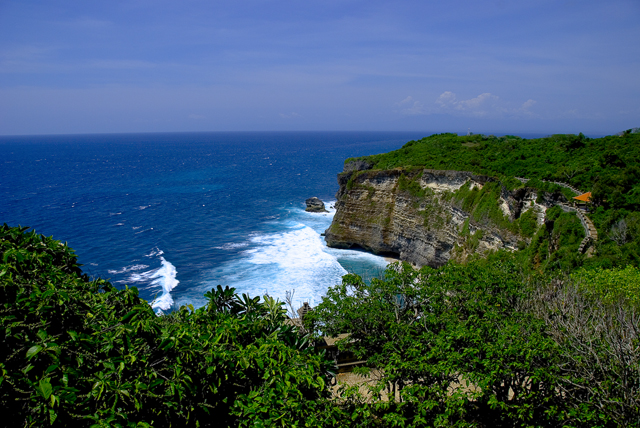
This is a large limestone peninsula which, bar a sliver of land just south of the airport, would be a separate island. It is rugged and dry, and pre-tourist development this was a real backwater of Bali.
The Bukit (as it is commonly referred to) includes the famous cliff-hanging temple at Uluwatu, a number of Bali's very best beaches including Balangan, and the top surfing spots on the island. As is so often the case, it was intrepid surfers who really opened up the eyes of the world to this part of the island.
The two main towns with strong local communities on the Bukit are Pecatu and Ungasan.
This article covers the whole of the Bukit Peninsula south of Jimbaran and west of Nusa Dua.
Uluwatu Temple (Pura Uluwatu) is one of Bali's nine key directional temples. Though a small temple was claimed to have existed beforehand, the structure was significantly expanded by a Javanese sage, Empu Kuturan in the 11th Century. Another sage from East Java, Dang Hyang Nirartha is credited for constructing the padmasana shrines and is claimed to have attained Moksha here. Even more remarkable than the temple itself is its location, perched on a steep cliff 70 metres above the roaring Indian ocean waves. There are more steep headlands on either side and sunsets over Uluwatu are a sight to behold.
The entrance fee is Rp 6,000 and you need to be properly dressed to enter. Sarongs and sashes are available free at the entrance. Guides, once famously mercenary, hassle visitors less than they used to, although they will offer to "protect" you from the monkeys, for a tip of course. Note that while you are free to walk around the temple grounds, the central courtyards can only be entered during special rituals.
The temple is inhabited by large number of monkeys, who are extremely adept at snatching visitors' belonging, including bags, cameras and eyeglasses. Keep a very close grip on all your belongings and stow away your eyeglasses if at all possible. If you do have something taken, the monkeys can usually be induced to exchange it for some fruit. Needless to say, rewarding the monkeys like this only encourages them to steal more. Locals and even the temple priests will be happy to do the job for you, naturally in exchange for a tip (Rp 10,000-50,000).
The cliff is fascinating but the temple itself is not as impressive as others in Bali.
There is also a very scenic cave underneath with rock formations leading onto a beach close to the temple. This is a popular spot for surfers.
Beaches
There are number of good white sand beaches on the Bukit Peninsula which many consider the best in Bali:
- Balangan. Rated by some as the single best beach in Bali and one which receives relatively few visitors. It takes a bit of finding but from the main junction at Ungasan heading out from Jimbaran towards Uluwatu turn right (west) by Nirmala Supermarket. The road then twists and turns for about 6 km until you reach the beach. Keep following informal signs to "Balangan" or "Balangan Surf" and a west-northwest bearing. This is a stunning beach and well worth the effort required in finding it. There are a few very laid-back warungs on the beach and even a couple of bungalows where you can stay the night.
- Bingin. Another white sand beach north of Padang-Padang and south of Dreamland. The beach here is not easy to access as the cliffs are high but the ocean views alone make the visit worthwhile. From the village of Pecatu head towards Padang-Padang and look for informal signs on your right directing you to "Bingin Surf". Proceed down the maze of small roads here, paying a Rp 3,000 toll if the village attendant is there, until you reach the obvious parking areas at the clifftop. There are two sets of steps down the cliff to the beach which are known as the northerly and southerly steps. Don't be surprised if you have to walk through grassy fields with cows and narrow pathways. Women offering massages might chase you from the parking lot. They'll back off after a firm 'no'.

Padang-Padang Beach
- Dreamland. Formerly a very beautiful beach which has been ruined by the adjacent Pecatu Graha Indah "New Kuta" development, sadly it has turned into "Nightmare-land". There are still excellent surfing conditions, especially for intermediate surfers & on days when other breaks are too big to surf. The break goes right & left, is not too shallow and has decent shape. If you do visit this beach, try to imagine how glorious it was before the bulldozers moved in. The entrance road to Pecatu Graha Indah is about 2 km southwest of Ungasan on Jl Uluwatu, and is impossible to miss adorned as it by huge statues and truly massive, intrusive billboards. The entrance fee to use the road down to the waterfront is currently Rp 10,000.
- Padang-Padang. A truly lovely beach with a big surf break offshore. Accessed from a stepped pathway on the north side of the obvious bridge 3 kilometres north of Uluwatu Temple heading back towards Pecatu. The white sand beach here is a little bit narrow at the highest of tides but is otherwise very nice indeed.
Suluban Beach. To the west of Padang-Padang Beach is secluded Suluban Beach, also known as Blue Point Beach. Access is not as public as that for Padang Padang, hence it is generally very quiet here. Even at high tides with the rolling surf, Suluban Beach has a rather wide sand beach. As tide recedes some 100 metres, Suluban Beach makes a nice exploratory wade among the rocks, corals and seaweed. The view from the Suluban cliff-line above is a show of spectacular ocean colours.
